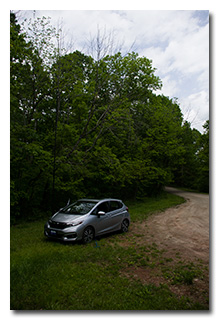
by William Eric McFadden
From the park's website:
-
Strouds Run State Park is located in the scenic forested hills of Athens County, in the midst of the unglaciated Appalachian Plateau. Although untouched by the vast ice sheets that moved across portions of the state over 12,000 years ago, Strouds Run displays the effects of the glaciers — in the deep ravines and high hills — where the valleys served as outlets for torrents of glacial meltwaters. The erosive power of these waters carved the valleys and hillsides, creating the familiar topography Ohioans know today. Large deposits of glacial outwash, primarily sand and gravel, were deposited along these streams and strongly affected the type of biological communities present today.
Pictures
- Eric's station, with little Theo-dog taking advantage of the shade under the car
- Eric's station, inside the car
Description
 On Saturday, May 23, 2020, one member of the Southeast Ohio Radio Adventure Team
performed a successful activation of Strouds Run State Park in Ohio as part of the Parks on the Air (POTA; link)
program. On a lovely Spring day following almost a week of rain, Eric McFadden, WD8RIF, performed the activation at the
park's Horseman's Area while maintaining proper social distancing during the coronavirus (COVID-19) crisis. Eric
was accompanied by his small dog, Theo.
On Saturday, May 23, 2020, one member of the Southeast Ohio Radio Adventure Team
performed a successful activation of Strouds Run State Park in Ohio as part of the Parks on the Air (POTA; link)
program. On a lovely Spring day following almost a week of rain, Eric McFadden, WD8RIF, performed the activation at the
park's Horseman's Area while maintaining proper social distancing during the coronavirus (COVID-19) crisis. Eric
was accompanied by his small dog, Theo.
Eric and Theo arrived at the Horseman's Area at 1650 UTC to find the area to be completely empty. (Where were the trucks and horse trailers Eric encountered last time? The weather would have been ideal for riding. Were the trails too muddy from the rain to risk taking the horses on?)
Eric parked his car at the extreme edge of the parking area, and while Theo explored, Eric quickly deployed his 28½' wire vertical on his Jackite 31' telescoping fiberglass mast and drive-on mount. Because of the need to ensure social distancing should others arrive, Eric set up his KX3 inside the car. Eric was on the air by 1702 UTC.
Starting on 80m, Eric's only QSO there was with his good friend K8RAT at 1707 UTC. After his subsequent calls of "CQ POTA" went unanswered, Eric switched to 40m at 1712 UTC.
Eric's first QSO on 40m came at 1714 UTC with KC2BPP in New York. QSOs came steadily on 40m, with Eric's ninth QSO on 40m coming at 1726 UTC with AB9BZ. Eric switched to 20m at 1732 UTC.
Eric's first QSO on 20m came at 1733 UTC with K8TE in New Mexico. Eric's fourth and final QSO on 20m came at 1741 UTC with KE1AK in Rhode Island. Eric switched to 30m at 1744 UTC.
Eric's first QSO on 30m was a result of Eric using POTA Spots to make a Park-to-Park (P2P) QSO at 1747 UTC with K0BWR who was activating Clinton State Park in Kansas. (It's possible that this was Eric's second P2P QSO of the day; K0BWR had worked Eric earlier on 40m, but Steve hadn't mentioned during that QSO that he was at a park.) QSOs came steadily on 30m, with Eric's fifth QSO on 30m coming at 1801 UTC with W1OPR in Maine.
In all, Eric made twenty QSOs, with one P2P QSO. All of Eric's QSOs were CW and were made at the 5-watt level.
Band conditions for this activation were very poor. On all the bands he used, Eric heard intermittent "dial telephone dialing-clicks" noise which he initially thought was local, but K8RAT later confirmed he, also, was hearing it on several bands at his QTH in central Ohio. Deep and fast signal fading was also a problem—Eric heard several stations answer his calls of "CQ" but these stations disappeared entirely before being able to give their exchange.
Eric also submitted his log to the World Wide Flora and Fauna in Amateur Radio (WWFF; link) program although he didn't make enough QSOs to to achieve a valid activation within the program which requires 44 QSOs be made. However, the WWFF program allows these 44 QSOs be made over any number of visits so a valid activation within WWFF is still possible if subsequent visits to the park are made.
(return)